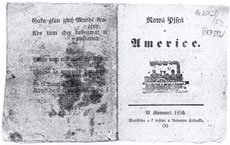Historic migration projects
The Friends of the Rozmberk Society have not yet been involved directly as partner in a historic migration project. The Czech Rozmberk Society is and has been involved in such projects. We helped our Rozmberk partners to obtain information needed for these projects and, if the project will be approved, will be involved again in the follow-up of the EMILE project.
 |
 |
 |
EMILE: Leaving Europe for America – early EMIgrants LEtter stories
The period 1840 through 1920 was one of great changes in Europe. Famine, poverty, overpopulation, and religious persecution forced millions of people to leave their homes and families in search for a new life elsewhere. The majority went to the United States, which promised jobs and freedom. When emigrating, they not only left behind oppression and poverty, but also families and friends, language, traditions, and customs. The first years as immigrants were, for almost everybody, years of severe hardships in many ways.
A source for learning and understanding of the immigrants’ situations is the ”America letters”; letters the immigrants wrote to the people left behind in their old country. These letters are important parts of the common European history. Nowadays the situation is the opposite, when Europe is hosting immigrants from other parts of the world. Giving voice to the experiences of the early European emigrants in America is one way of linking the history and the present and creating understanding for the new immigrants.
The aim of the EMILE project was to study and compare that part of European common history as told in letters from America written by early European emigrants focusing on the individual points of view found in letters and other personal documents. A joint traveling exhibition was produced, combining the collections of letters, songs, and traditions from the different partner countries along specific themes. It shows both the similarities and differences between the experiences from those different countries. Exhibition themes include reasons to emigrate, problems of early settlers, integration, the role of women in settling the Mid-West, the success of today’s descendants of yesterday ‘s immigrants. The existing databases on emigrant letters collected by the partners continues to be updated on the EMILE emigrant letters website.
This project started in September 2004 and the main activities were completed in September 2005. Updating the website and some other activities continue even now as voluntary work. The project was financed under the EU Culture 2000 Program and partners are from Sweden, Ireland, Poland, Italy, and the Czech Republic.
The partners of the EMILE project are preparing an application for an extension of the project (called SAME), this time focusing on the American site of the stories. The plan is to organize two day migration festival (outdoor/indoor) in two major American cities (Minneapolis and New York or Boston). The festival will be designed partly to make people experience the historical migration links between Europe and America in a broad sense, partly to show examples of modern popular cultural expressions linked to Europe and USA. The migration festival will be designed to attract all ages, especially young people whose ancestors may have European origin.
MIR I: Migration and Intercultural Relations, Challenges for Schools today
This 3-year project was running under the EU Education Program Comenius. The project linked primary and secondary schools, teacher training institutions, research institutions, museums, and archives into a thematic network comprising seven EU countries. Its results can be viewed on the migration history website
The Czech partner group included three primary and secondary schools, the University of South Bohemian, and the Rozmberk Society. This project aimed to help children and teachers to better understand migrants in their schools, migration problems, and the positive aspects of other cultures. Historic migration (1850-1900) from the partner countries to the USA is used to make migration more understandable; many Europeans have in their ancestry also relatives who emigrated. The Network connects the different partners, which each addresses the topics through subprojects between Network partners or between partners and institutions outside the network. The Rozmberk Society focused mainly on the historic emigration to America.
MIR II: LEARNING-MIGRATION
Learning about migration and intercultural relations in school and teacher training
The partners of MIR managed to get approval for extending the MIR network and project through the in 2005 approved MIR II project (2006-2008). The MIR II network focuses on enhancing today's education in migration studies and intercultural education. Although the main focus is on today's migration and migrant problematics, the Rozmberk Society continues to be involved as a consulting partner. Results can be viewed on the new MIR II webpages.
Unless mentioned differently, all pictures are © collection Rozmberk Society, Friends of the Rozmberk Society, or provided under © by individual partners. In some instances, copyright is public domain or could not be established or obtained within reasonable effort.
Design by the Bear (Robert Dulfer 2006-2016)


